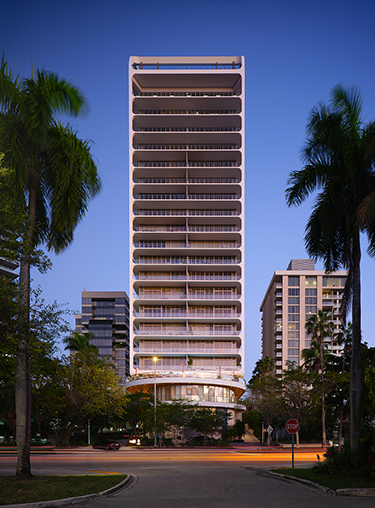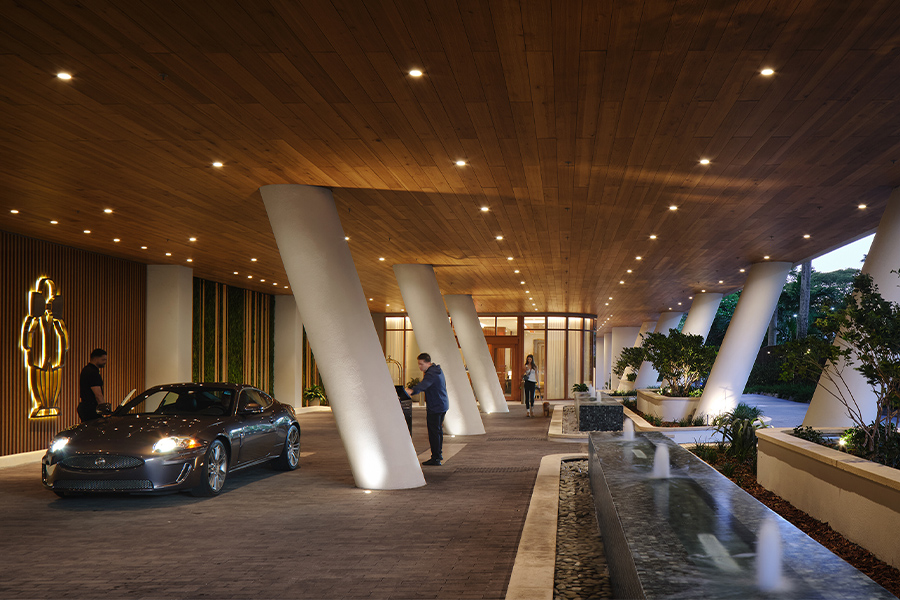Miami was markedly different in 1975 when Bernardo Fort-Brescia, newly armed with a Master of Architecture degree from Harvard University, first arrived in the city to teach at the University of Miami. Then an epicenter for sun-seeking vacationers and retirees, it was on the cusp of glamorous change.
Two years later, Fort-Brescia and four partners, including his wife Laurinda H. Spear, established Arquitectonica in Coconut Grove. (Only Fort-Brescia and Spear have been involved since the 1980s.) The architecture and design firm—now a global powerhouse—was born out of circumstance. A major recession was in its final throes and the ambitious founders, stymied by a hostile job market, were so eager to work that they launched a studio of their own.

Mr. C Residences Coconut Grove occupies two towers crafted as sails gliding toward Biscayne Bay
Financial challenges aside, the atmosphere was ripe for their bold ideas. “Miami was transforming itself from a place where New Yorkers came for the winter to an international city, the capital of Latin America. We just happened to be here for it,” recalls Fort-Brescia.
Local commissions came quickly to the experimental practice, beginning with the now-demolished Babylon Apartments, a six-story structure that stood out for its ziggurat form. By 1982, Arquitectonica had completed Atlantis, the luxury condominium apartment building dazzling Biscayne Bay with a cube carved into the center of the façade cinematically showcasing a whirlpool, palm tree, and red staircase. It was so evocative of the flashy era, it appeared in the opening credits of the 1980s hit “Miami Vice.” “The reach was gigantic. We certainly benefitted from the power of television,” points out Fort-Brescia.
Such a pop culture cameo underscores Arquitectonica’s outsize influence on the Miami skyline. “The zoning was changing so we could build high-rises early on,” he says. “We were trying to redefine Miami. There were uninspired buildings going up at the time. Nothing had really happened since the Art Deco period except for Morris Lapidus’ hotels. It was an opportunity to amend a city, to find the right architecture for the place and time.”

A wave-like form characterizes Testimonio II’s mixed-use towers, Elsa and Reseda, in Monaco
Through projects like the Wilkie D. Ferguson Jr. U.S. Courthouse, Kaseya Center, mixed-use Brickell City Centre development, and PortMiami expansions including Virgin Voyages’ Terminal V and the recently unveiled MSC Cruises Terminal, Arquitectonica continues to shape Miami. The 20,000-square-foot LEED-certified studio designed for the University of Miami School of Architecture is particularly poignant, capturing Fort-Brescia’s longtime dedication to the school that altered the course of his life.
But its international imprint is equally strong. Over the decades, offices have sprouted in nearby Palm Beach, as well as New York, Los Angeles, Lima, São Paulo, Paris, Dubai, Hong Kong, Shanghai, and Manila, manifesting in such memorable creations as the Dijon Performing Arts Center in France, the Agricultural Bank of China Headquarters in Shanghai, and the International Finance Center Seoul and Conrad Hotel in South Korea.
Fort-Brescia’s career is long and accomplished, but unsurprising to those who knew him in his early years. “In school, I was always choosing the table in the rear so I could be sketching while the teachers were talking and all my classmates knew that’s what I was doing,” he remembers.

The Well Coconut Grove boasts a coral stone façade that honors the area’s architectural history
Fort-Brescia first left his native Peru in the 1970s for the U.S. to attend Princeton University in New Jersey. Although a degree in economics was the goal, it was architecture and urban planning that beckoned. Upon telling his parents about the change, they buoyed him by admitting they always thought he would take this path.
He grew up outside of Lima in an area surrounded by farmland, but by the time Fort-Brescia was a teenager, the landscape resembled a city. Construction was rampant and developments were popping up. “It went from agriculture to urbanism in 20 years, and that got me interested in architecture because I could see what was being built around me,” he says. “I always knew I wanted to be an architect, but I didn’t know if I would be.”
Today, Arquitectonica’s expertise stretches across the residential, civic, cultural, corporate, educational, and hospitality realms, but Fort-Brescia has a soft spot for hotels, having brought properties like Miami’s former SLS Brickell Hotel & Residences and the Thompson Mexico City to life.

The design of Mr. C Residences Coconut Grove in Miami evokes living on a yacht
Currently, Arquitectonica is handling the forthcoming Thompson Puerto Vallarta and Grand Hyatt Miami Beach Convention Center Hotel, both slated for 2027, as well as 8850 Sunset, a West Hollywood development incorporating a revamped version of storied club the Viper Room, a public plaza, and a 5-Star hotel.
There’s also Mr. C, the chic restaurant-centric hotel and residences brand conceived by Ignazio and Maggio Cipriani. Arquitectonica collaborated with Meyer Davis on its Coconut Grove and soon-to-open West Palm Beach locations, as well as the downtown and Jumeirah residences in Dubai.
RELATED: Mr. C Residences Downtown Adds Elegance to the Dubai Skyline
“I enjoy the gastronomic side. It’s a restaurant with a hotel, not a hotel with a restaurant,” says Fort-Brescia of Mr. C. Coconut Grove, where Italian dishes served at Bellini are the centerpiece. Throughout Mr. C, “you feel like you’re on a superyacht with all the shiny wood and chrome.”
Fort-Brescia and his team always approach hotels as multidimensional buildings, “from the sense of arrival to the goodbye and what happens in between. The visitor has a complete experience of a day when they stay at a hotel. They have a meal, they exercise, they work. Life happens in one place,” he explains. “There’s a first impression but then there’s a lasting impression—the memory, which reminds them that they had a wonderful experience.”
Photos and renderings by Andrius Gudelis, Tam Wai Man, Kendall McCaugherty, and courtesy of Arquitectonica
This article originally appeared in HD’s November 2025 issue.


